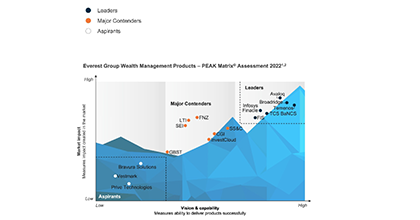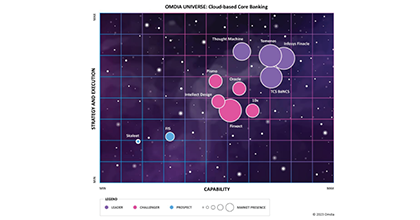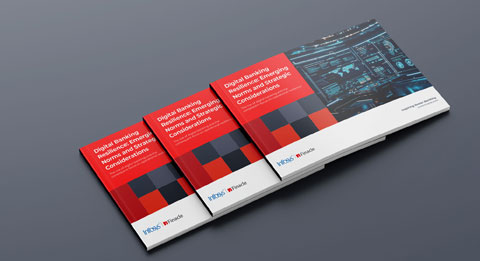-
![]() ESG in bankingESG-conscious banking should create new and future-proof value streams to build a sustainable and resilient business.Read More
ESG in bankingESG-conscious banking should create new and future-proof value streams to build a sustainable and resilient business.Read More -
![Everest Group PEAK Matri Everest Group PEAK Matri]() Everest Group PEAK MatrixA comprehensive solution delivering a full spectrum of wealth products as great experiences. It also improves the productivity of financial advisors and streamlRead More
Everest Group PEAK MatrixA comprehensive solution delivering a full spectrum of wealth products as great experiences. It also improves the productivity of financial advisors and streamlRead More -
![]() Subsidiary of an American Bank in IndonesiaFind out how a leading American bank adapts to a digitalized trade and supply chain finance operations as a part of its larger transformation by leveraging Finacle Trade Finance Solution Suite.Read More
Subsidiary of an American Bank in IndonesiaFind out how a leading American bank adapts to a digitalized trade and supply chain finance operations as a part of its larger transformation by leveraging Finacle Trade Finance Solution Suite.Read More
-
![]() Recomposing Banking: Leading the Digital ContinuumReport gives you a glimpse of the major areas where recomposing banking will create significant impact and value, Infosys Finacle has put together a report on..Read More
Recomposing Banking: Leading the Digital ContinuumReport gives you a glimpse of the major areas where recomposing banking will create significant impact and value, Infosys Finacle has put together a report on..Read More -
![]() Core Banking on Cloud: Navigating to the Fast LaneTake a deep dive into cloud-based core banking and explore the imperatives, opportunities and challenges, and the hallmarks of a robust solution.Read More
Core Banking on Cloud: Navigating to the Fast LaneTake a deep dive into cloud-based core banking and explore the imperatives, opportunities and challenges, and the hallmarks of a robust solution.Read More -
![]() Embracing Payments ComposabilityA step-by-step guide for maximizing Real Time Payment opportunities by embracing Payments Composability...Read More
Embracing Payments ComposabilityA step-by-step guide for maximizing Real Time Payment opportunities by embracing Payments Composability...Read More
-
![]() Shaping Banking’s Next: Banking Technology Trends for 2025 and BeyondThe banking industry has been balancing disruption and opportunity for several years now, and the pace of change shows no signs of slowing as we move into 2025 and beyond.Read More
Shaping Banking’s Next: Banking Technology Trends for 2025 and BeyondThe banking industry has been balancing disruption and opportunity for several years now, and the pace of change shows no signs of slowing as we move into 2025 and beyond.Read More -
![]() Virtual Accounts 2.0: Surpass Conventional Cash Management and Unlock Next-Gen PossibilitiesVirtual Account Management was a groundbreaking shift in the banking landscape, revolutionising use cases like cash concentration, pooling, centralised treasury management, and in-house banking (POBO, ROBO, COBO)Read More
Virtual Accounts 2.0: Surpass Conventional Cash Management and Unlock Next-Gen PossibilitiesVirtual Account Management was a groundbreaking shift in the banking landscape, revolutionising use cases like cash concentration, pooling, centralised treasury management, and in-house banking (POBO, ROBO, COBO)Read More -
![]() Unlocking Hybrid CloudAs banks push forward with their digital transformation agenda, cloud serves as a pivotal enabler. Each bank, at varying stages of adoption, crafts its unique path, dictated by context, regulations, and risk appetite.Read More
Unlocking Hybrid CloudAs banks push forward with their digital transformation agenda, cloud serves as a pivotal enabler. Each bank, at varying stages of adoption, crafts its unique path, dictated by context, regulations, and risk appetite.Read More
-
![]() Banking on CloudThis report from Infosys Finacle delves into the need for accelerating cloud adoption, highlights the current state of the industry, and puts forth key recommenRead More
Banking on CloudThis report from Infosys Finacle delves into the need for accelerating cloud adoption, highlights the current state of the industry, and puts forth key recommenRead More -
![]() Omdia Universe | Cloud-based Core BankingIn the report, Omdia highlights the following key capabilities of leading cloud-based core banking providers:Read more
Omdia Universe | Cloud-based Core BankingIn the report, Omdia highlights the following key capabilities of leading cloud-based core banking providers:Read more
-
![]() Emirates NBDEmirates NBD consolidates its operations on a single version for scalability, agility, and standardization.Read More
Emirates NBDEmirates NBD consolidates its operations on a single version for scalability, agility, and standardization.Read More -
![]() A Global Top 5 BankDiscover how a global top 5 bank headquartered in the US accelerated payments transformation.Read More
A Global Top 5 BankDiscover how a global top 5 bank headquartered in the US accelerated payments transformation.Read More -
![]() Union Bank of IndiaUnion Bank of India launches Union Virtual Connect (UVConn) by leveraging WhatsApp to provide customers personalized banking services.Read More
Union Bank of IndiaUnion Bank of India launches Union Virtual Connect (UVConn) by leveraging WhatsApp to provide customers personalized banking services.Read More

Deciphering Blockchain and Our Future
Blogs
A LAYMAN GUIDE TO BLOCKCHAIN AND IT’S WORKING…
We undertake a number of contracts & transactions on a daily basis; across regions, countries, industries; as individuals, as small business owners and of course as large corporates. During these transactions, a lot of documents and contracts are created and need to be stored, verified and maintained. We rely on intermediaries and ‘trust’ keepers to see our transaction through safely, seamlessly and without disruption.
Think of the last time you moved money between countries, or paid your supplier in a different country; you had to go through a process of identification and verification at your local bank, there were intermediate banks / clearing houses which assimilated, verified and passed on your information and value (Important!!) before finally, it reached the other end. Often times the ‘trust’ and value you pass on cannot be verified and then your bank calls you up to sort that out and then proceed.
The reality is that all of us have aligned ourselves to these processes, or delays, as part of our life. In fact, we are used to saying – that’s the way it works, and will in the future.
Or will it?
In Dec 1974, Vint Cerf and Robert Kahn designed the foundation of our Internet –TCP/IP. Initially, TCP/IP allowed us to connect and send emails, and then it transformed into a wonderful, organic way of communication through a computer at both ends. Today, this has ingrained itself in our daily lives.
And this is what Blockchain, I believe will do. While of course, the final state of the Blockchain revolution is many years away, the process has started. It is important to understand that Blockchain in itself is not disruptive. Blockchain, as I have learned to appreciate, is a foundational technology and will end up creating new foundations for global, economic and social structures. The world will be perceived differently – Pre Blockchain and Post Blockchain perhaps!!!
Blockchain and Core Building Blocks
Blockchain, simply put, is an open, distributed ledger that can record transactions between two parties efficiently and in a verifiable and permanent way. The ledger itself can also be programmed to trigger transactions automatically.
Blockchain, while an innovation, is not a NEW technology – it’s a coming together of three technologies
- Distributed, Peer to Peer Network with a shared ledger
- Private Key Cryptography
- Incentivization Protocol – an incentive to service the network’s transactions, record-keeping and security.
Private Key Cryptography
This component of Blockchain serves to establish one of the key Blockchain concepts – SECURE DIGITAL IDENTITY. Identity is based on a possession of a combination of a public and a private key. The combination of these keys forms a very useful digital signature.
Distributed Network
This component technology helps in APPROVING TRANSACTIONS THROUGH CONSENSUS and MAINTAINING A TRUSTED SHARED RECORD
When a node (A) initiates a transaction with another node (B) in the Blockchain, by the very nature of the protocol, a new block is added to the record (Ledger). Since this ledger is shared by all the nodes in the blockchain, the next step is for these nodes to start validating the transaction to verify if indeed A has the funds for e.g. to transfer to B. Validating the transaction involves going back to the 1st transaction (block) in the chain and accounting for every transaction in the chain, before arriving at a confirmation on the transaction’s genuineness. Once a majority of the nodes verify this new transaction and confirm, it’s then that the new transaction is added to the system of records (a new Block is confirmed and added to the chain).
Incentivization
The integrity of the blockchain requires many participants to be constituting the peer to peer distributed network (and consequentially the very high-power consumption). One of the cleverest parts of the BTC blockchain is its incentive for participating in the expensive consensus-building process. Every time a new block is accepted, the system randomly rewards one participant with a reward or token. In a Bitcoin Blockchain, this is how new Bitcoins are created or “mined”.


©2025 -Edgeverve Systems Limited | All rights reserved

















